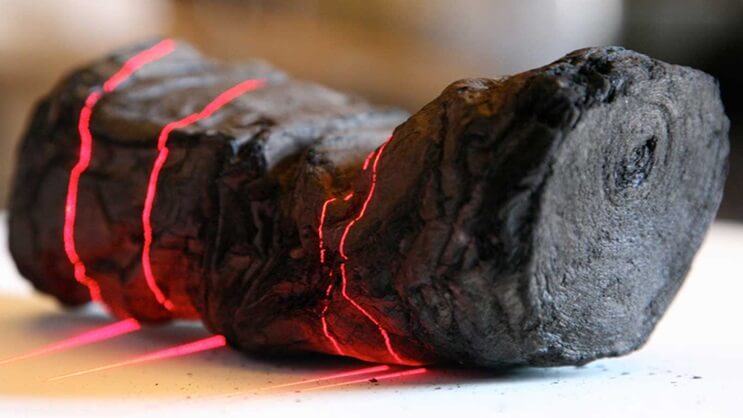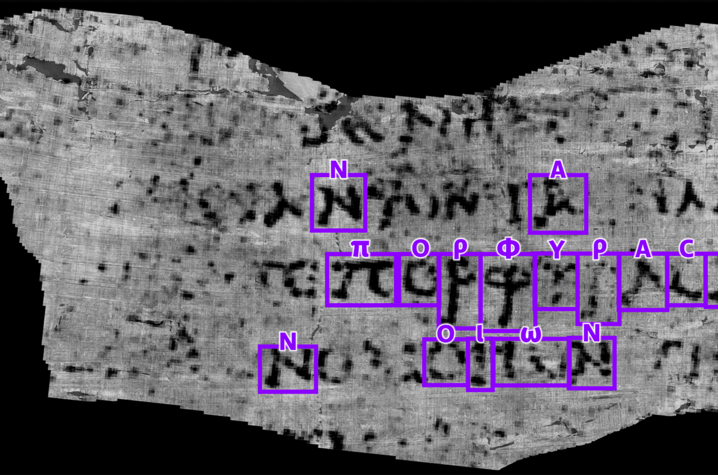
This 21 Year Old Used A.I. To Decipher Text From A Scroll That Hasn’t Been Read In 2,000 Years
The papyrus scroll is one of hundreds that were carbonized in the eruption of Mount Vesuvius in 79 C.E.
By: Julia Binswanger | Smithsonian
A computer science student has won $40,000 for deciphering the first word on an ancient Roman scroll carbonized by Mount Vesuvius’ eruption in 79 C.E.
The papyrus scroll looks more like a burnt log than an ancient text, and it’s so fragile that it would fall apart if researchers tried to unroll it. The student, Luke Farritor, 21, used artificial intelligence to identify a single word on the unopened scroll: “porphyras,” an ancient Greek word for “purple,” researchers announced last week.
The text is one of some 800 scrolls unearthed in the ancient Roman city of Herculaneum in the 1700s. Archaeologists discovered the trove in a villa that may have belonged to Julius Caesar’s father-in-law, a senior Roman statesman.
Until very recently, reading even a single letter on the carbonized papyrus seemed impossible. Early attempts to unroll and read the scrolls left them irreversibly damaged, and no such attempts have been made since the 19th century, according to the New York Times’ Nicholas Wade. The discovery of the word “porphyras” opens the door to eventually deciphering the rest of the texts.

“Some 95% of the material from the classical period is lost, so we just don’t have anything,” says Brent Seales, a computer scientist at the University of Kentucky, to National Geographic’s Sarah Kuta. “And yet we know it was one of the most important philosophical periods of humanity. It’s an era shrouded in mystery for which we’ve lost most of the material.”
12,000 Year Old Massive Underground Tunnels Are Real And Stretch From Scotland To Turkey
Seales has been working on techniques to decipher the scrolls for over 20 years. An important step was perfecting the use of CT scan technology to see what’s inside them without actually touching them, a process he calls “virtual unwrapping,” as he explains in a video announcing the discovery. In 2016, Seales’ team unwrapped what’s known as the En-Gedi scroll, which featured sections of the Book of Leviticus. Because the ink contained metal, it could be seen on Seales’ CT scans. Unfortunately, the Herculaneum scrolls were written in carbon-based ink made from charcoal and water. When Seales scanned them, nothing appeared to the naked eye.
Earlier this year, Seales’ team launched the Vesuvius Challenge, a contest that offers prize money to anyone who can use A.I. to help decipher researchers’ scans. “We all agreed we would rather get to the reading of what’s inside sooner, than try to hoard everything,” says Seales to Nature’s Jo Marchant.
In early August, contestant Casey Handmer, an entrepreneur, won $10,000 for being “the first person to find substantial, convincing evidence of ink within the unopened scrolls,” per the Vesuvius Challenge’s announcement. “His insights led directly to [Farritor’s] discovery.” Handmer wrote a blog post detailing his discovery of a “crackle pattern” on the scroll that appeared to be ink.
From such crackle patterns, Farritor created a machine-learning algorithm that identified ten legible letters on a small segment of parchment. When he realized his method had succeeded, “I saw these letters, and I just completely freaked out,” he recalls in the video announcement. “I freaked out. I almost fell over, almost cried.”
Soon after Farritor’s discovery, Youssef Nader, a biorobotics researcher, independently identified the same word, “porphyras.” He won a second-place prize of $10,000.
The Vesuvius Challenge is still ongoing. A grand prize of $700,000 will be awarded to the first contestant to read four passages of at least 140 characters.
These discoveries are critical steps toward deciphering the remaining unopened scrolls in the villa. “Recovering such a library would transform our knowledge of the ancient world in ways we can hardly imagine,” says Robert Fowler, a classicist at the University of Bristol in England, to the Times. “The impact could be as great as the rediscovery of manuscripts during the Renaissance.”
According to the Vesuvius Challenge’s website, many historians think thousands more scrolls are waiting to be uncovered in the villa. “This word is our first dive into an unopened ancient book,” Seales tells the Guardian’s Ian Sample.
“What will the context show?” he adds. “Pliny the Elder explores ‘purple’ in his ‘natural history’ as a production process for Tyrian purple from shellfish. The Gospel of Mark describes how Jesus was mocked as he was clothed in purple robes before crucifixion. What this particular scroll is discussing is still unknown, but I believe it will soon be revealed. An old, new story that starts for us with ‘purple’ is an incredible place to be.”
* * *
NEXT UP!
Joyeuse: The Legendary Sword of Charlemagne
The sword of Joyeuse, which today sits in the Louvre Museum, is one of the most famous swords in history. Historical records link the sword to Charlemagne the Great, King of the Franks.
If it did indeed belong to the famous king, who reigned some 1,200 years ago, the sword of Joyeuse would have been used in countless coronation ceremonies, and is tied with ancient myth and legend ascribing it with magical powers.
The story begins in the year 802 AD. Legend states that the sword of Joyeuse, meaning “joyful” in French, was forged by the famous blacksmith Galas, and took three years to complete. The sword was described as having magical powers associated with it. It was said to have been so bright that it could outshine the sun and blind its wielder’s enemies in battle, and any person who wielded the legendary sword could not be poisoned. The Emperor Charlemagne, coming back from Spain was said to have set up camp in the region and acquired the sword.
* * *
READ MORE: Anunnaki Artefacts That NASA Is Hiding (Video)
Read more on Ancient Artefacts: This Man Underwent Brain Surgery 3,500 Years Ago
Liked it? Take a second to support Collective Spark.
We’d love to hear from you! If you have a comment about this article or if you have a tip for a future Collective Spark Story please let us know below in the comment section.
